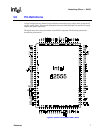
Datasheet 11
Networking Silicon — 82555
3.8 Miscellaneous Control Pins
Symbol Pin Type Name and Function
RESET 1 I
Reset.
The Reset signal is active high and resets the 82555. A reset pulse
width of at least 1
µ
s should be used.
FRC100
(MACTYP)
51 I This pin is multiplexed and can be used for one of the following:
Force 100/10 Mbps.
In repeater mode, this pin configures the repeater to
either 100 Mbps (active high) or to 10 Mbps (active low).
MAC Type.
In DTE (adapter) full duplex mode, if this input signal is high, the
82555 drives 82557 mode. If this input signal is low, the 82555 drives a
generic MII MAC mode.
PHYA4
(TIN)
22 I This pin is multiplexed and can be used for one of the following:
PHY Address 4.
In repeater mode, this signal represents the fifth bit for
address port configuration.
TIN.
If the Test Enable signal is active, this signal is used as the Test Input
data.
PHYA3
(SLVTRI)
52 I/O This pin is multiplexed and can be used for one of the following:
PHY Address 3.
In repeater mode, this signal represents the fourth bit for
address port configuration.
Slave Tri-state.
In DTE (adapter) mode, this output operates in conjunction
with the T4 Advanced signal. When both are active, the slave PHY is inactive
and tri-states all its outputs.
PHYA2
(LISTAT)
6 I This pin is multiplexed and can be used for one of the following:
PHY Address 2.
In repeater mode, this signal represents the third bit for
address port configuration.
Link Status.
In DTE (adapter) mode, if T4 Advance is active, the LISTAT_N
signal is active low and the slave PHY link is valid.
PHYA1
(TEXEC)
25 I This pin is multiplexed and can be used for one of the following:
PHY Address 1.
In repeater mode, this signal represents the second bit for
address port configuration.
Test Execute.
If Test Enable is asserted, this signal acts as the test
execution command indicating that the pin 22 is being used as the Test Input
pin.
PHYA0
(TCK)
24 I This pin is multiplexed and can be used for one of the following:
PHY Address 0.
In repeater mode, this signal represents the first bit for
address port configuration.
Test Clock.
If Test Enable is asserted, this signal acts as the Test Clock
signal.
ANDIS
(T4ADV)
54 I This pin is multiplexed and can be used for one of the following:
Auto-Negotiation Disable.
In repeater mode, the Auto-Negotiation operates
for management reasons. If this input signal is high, the Auto-Negotiation
operation will be disabled.
T4ADV.
In DTE (adapter) mode, this pin enables the combo mode. This
allows the LISTAT and SLVTRI pins to be used as interface to the slave PHY.
SCRMBY 23 I
Scrambler/Descrambler Bypass.
If SCRMBY is high, the scrambler/
descrambler of TP-PMD will be bypassed.
LPBK 2 I
Loopback.
When the LPBK signal is high, the 82555 will perform a
diagnostic loopback function.
RPT 50 I
Repeater.
When the RPT signal is high, the 82555 functions in repeater
mode. When this signal is low, the 82555 runs in DTE (adapter) mode.
TESTEN 21 I
Test.
If the TESTEN signal is high, the 82555 enables the test ports.


















